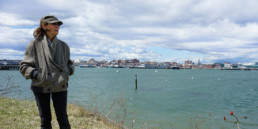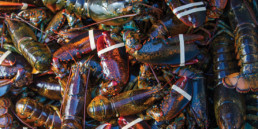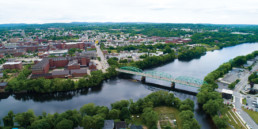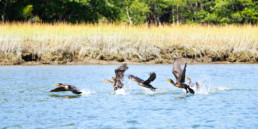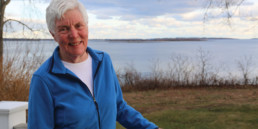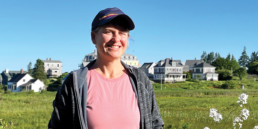Quahoggers rake in their catch while fishing in
Narragansett Bay near Warwick, R.I.
Photo: David Wells / Alamy Stock
Changing Fisheries on Narragansett Bay
Cleaner waters, but fishing culture and fish species in flux
By Ari Snider
There’s a small-state joke in northern Rhode Island that goes like this: If you’re headed to South County, you better pack a lunch for the road. Of course, South County is only about a 50-minute drive from Providence, but to be fair, it’s pretty much as far as you can go without leaving the Ocean State.
Whether or not you bring your lunch pail, Fred Mattera hopes you at least consider buying dinner in South County.
“What we’re trying to do is get you to buy a whole fish,” he said. “Take it home—it’s cheaper for you—and filet it.”
Mattera is executive director of the Commercial Fisheries Center of Rhode Island, and selling more fish locally is one of his top priorities.
Mattera is also a lifelong commercial fisherman, and only recently hung up his captain’s hat. He got his start in the early 1970s on day boats—wooden vessels that worked Narragansett Bay and coastal waters. Over the years, the fleet has transitioned to larger vessels and offshore grounds.
These days, “you can probably count on this hand how many boats actively fish in the bay,” Mattera said, holding up one hand on a Zoom call. “It’s unfortunate.”
That doesn’t mean the bay is bereft of commercial fishermen—far from it. Hundreds of shellfishermen continue to harvest mussels, whelks, quahogs, and other mollusks from small boats, carrying on an age-old practice. Aquaculture, mainly in the form of oyster farms, has emerged more recently as a major player in the aquatic economy alongside wild harvesters.
Around the time that Mattera was getting his sea legs on the day boat fleet, farther up the bay Mike McGiveney was making his first investments in quahog gear.
“I bought my first boat when I was 12, with my paper route money,” said McGiveney, who is now president of the Rhode Island Shellfisherman’s Association. By the time he graduated from the University of Rhode Island, he was a full-time quahogger.
“I really haven’t done anything else for the last 40 years,” he said with a laugh.
Quahogs are a type of hardshell clam, and figure prominently in Rhode Island’s culinary history. Less flashy than calamari—the state has claimed the title of “calamari capital,” thanks to massive squid harvests in recent years—the humble bivalve is nevertheless a mainstay for shellfishermen. Even as other species go through cycles of abundance and decline, “quahogs have always been here,” McGiveney said.
Less steady is interest in shellfishing as a job, and a current challenge for the industry is slow recruitment. “Unfortunately, the preponderance of the shellfishermen are older guys, like me,” McGiveney said.
But there’s something on the horizon that he’s hoping will generate a little more buzz around the industry, perhaps enticing some younger would-be shellfishermen to pick up a rake and jump aboard: New fishing grounds are opening up in the Providence River, the northernmost arm of the bay, grounds that haven’t been harvested in over 70 years.
The expanded territory is a direct result of longstanding efforts to clean up the bay, especially the northern reaches which are closest to Providence.
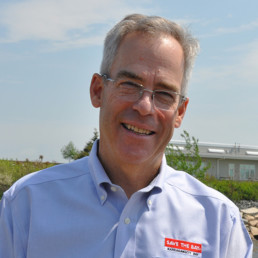
Jonathan Stone of Save the Bay
When I landed in Providence as an undergrad at Brown University in 2014, I was warned that anyone who fell into the harbor would be whisked directly to the hospital, so poisonous was the water. In hindsight, I think this was likely a fictionalized snippet of urban lore used to scare we first-year students, but when Jonathan Stone was at Brown, several decades earlier, you probably wouldn’t have wanted to chance it either way.
“It was just a foul place,” said Stone. As a member of the crew team in the late 1970s, he would know. “At that time there was raw sewage, regularly, in the water,” he remembers.
Stone is now executive director of Save the Bay, an environmental advocacy group dedicated to restoring and protecting Rhode Island’s central geographic feature—no small task.
Narragansett Bay has taken a beating ever since the industrial revolution first cranked into gear in Pawtucket, just upriver. From the textile industry to jewelry manufacturing, the bay was on the wrong end of outflow pipes discharging dyes, chemicals, or toxic metals for well over 150 years.
Then there was the problem of untreated wastewater. In addition to being gross, raw sewage overloaded the bay with nitrogen, causing algal blooms and, in turn, massive fish kills.
An exceptionally large die-off occurred in 2003, in an area where McGiveney and others harvest shellfish, and it made front page news. Save the Bay took a leading role in getting a law passed to rein in wastewater treatment plants, and in the last 17 years Stone says nitrogen loading into the bay from those plants has been cut in half.
The cleanup of the bay has been so successful that some wonder if it’s having unintended consequences. Even as new portions of the upper bay are now clean enough to harvest quahogs, McGiveney says he’s seen shellfish bed productivity decline in the lower bay, which he thinks could be a result of less organic matter in the water.
“Really it’s like Goldilocks,” he said, referring to levels of nitrogen and other nutrients. “You don’t know how much is too much, and how much is too little.”
To Anna Mercer, chief of the Cooperative Research Branch at NOAA’s Northeast Fisheries Science Center, the debate over nutrient levels is a direct consequence of humans trying to manage a complex marine ecosystem for multiple uses.
“We knew that the bay was polluted by wastewater, but we don’t know what the ‘right’ level of productivity is,” she wrote in an email. “Although it looks ‘clean’, it is not supporting the abundance and diversity of marine life that it once did.”
However the debate over nutrient levels unfolds, climate change is the 800-pound marine mammal in the room.
Warming waters have already altered the species composition of the bay, a shift so significant that Mercer said “some have classified [it] as kind of a regime shift.”
Mercer, who has a long history of working with fishermen to study commercial fisheries in southern New England, brings up the example of winter flounder, which used to spawn in abundance in the bay.
“But as the water has warmed,” she said, “Narragansett Bay is now nearly inhospitable to winter flounder of different life stages.” The lobster fishery is also on the decline, reflecting a regional trend as the crustaceans shift northward toward cooler waters.
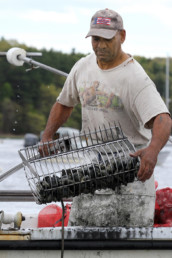
A quahogger pulls up a rake full of quahogs near Greenwich Cove.
Photo: Bob Breidenbach / USA Today Network
Mercer stresses that isolating climate change as a unique variable is not easy. “Trying to identify specifically a cause and effect,” she said, “of ‘this is happening because of a changing climate’ is actually really difficult to do.” That means there are a lot of unresolved questions floating around.
From the 10,000-foot view, though, the broader impacts of climate change come into clearer focus: waters are warming, species distribution and abundance are changing, and fishermen are trying to keep up.
Mercer says that is not necessarily all bad. “Change is forcing the industry to adapt, which is something that they’ve always been good at,” she said. Lobstermen are targeting Jonah crab, and boom years in the squid fishery have more than made up for the loss of winter flounder, at least from an economic perspective.
“I do believe, and I think the science supports, that we can continue to have sustainable and prosperous fisheries,” Mercer added. “Even if it’s going to look different in the years to come.”
So while it’s always advisable to pack a lunch when you’re headed to South County, you might also want to keep an open mind about what kind of fish you’ll bring home for dinner.
Ari Snider is a journalist from Belfast. He’s worked most recently for public radio stations in West Texas and Southeast Alaska.

